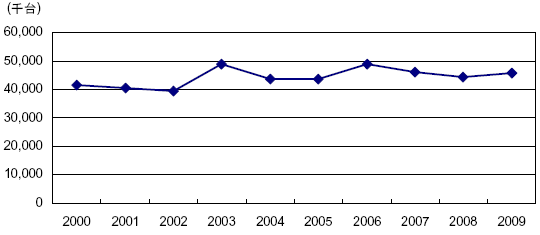Japanese Cell Phone Sales Set to Surge in 2006

Market research firm Gartner Japan has good news and bad news for cell phone manufacturers and telecos. The company predicts Japanese handsets sales could reach 49 million units in 2006 as mobile number portability finally makes it debut and consumers trade up to faster, smarter handsets on their carrier of choice. That’s good news since sales for 2005 are looking rather flat especially compared to those halcyon days of 2003 when the debut of the camera phone helped drive sales to over 48 million units. Bad news is that Gartner’s research [.pdf in Japanese] indicates sales will fall again sometime in 2007 once consumers have replaced their current handsets.
Of course it doesn’t take costly research to know telecos here have a lot to worry about. With the domestic cell phone market fast reaching saturation point DoCoMo, KDDI and Vodafone will have to depend not only on handset replacement but rolling out comprehensive mobile consumer, retail, and data-related services — both in-house and through partners — to retain customers and keep income flowing in the right direction.
Spring of 2006 means the start-up of digital terrestrial broadcasting and content providers are partnering with TV broadcasters to bring a range of TV-related services onto mobile phones. However since most of these services will be available regardless of carrier, it will not help telecos hold onto customers.
Number portability has the whole sector jittery. From this fall through 2006 telecos hope to dazzle consumers with an even more refined menu of exclusive 3G services. Just out from KDDI for example, a cell-phone based car navigation system that not only displays maps but provides voice instructions through the cell phone speaker. KDDI estimates due to their high price tag, only around 20 percent of drivers have a car navigation system. Now for just 315 yen a month (US$2.87), drivers can switch on the phone for driving instructions. The service even obliges with updated information on car parks and can guide drivers right to the spot.
Interestingly, Gartner says that compared to the success of camera phones, 2005 numbers so far show music has not been the killer application telecom carriers had perhaps hoped for. Bells and whistles aside, affordable price plans are probably what will really inspire loyalty to individual carriers. Economical flat rate plans and discounted services are already becoming important factors in advertising campaigns and marketing.
Cell phone manufacturers have their own problems. Faced with increasingly costly development for complex 3G phones it?fs no secret that with few exceptions, cell phone divisions at major electronic houses are racking up significant losses. They are going to be counting on the next wave in the cell phone replacement cycle, two years or less in this market, to wash some of the red from their debit columns even if only temporarily. Garnter predicts sales in 2007 will fall from 49 million units to close to 46 million and in 2008 only reach around 44 million.
— Gail Nakada

